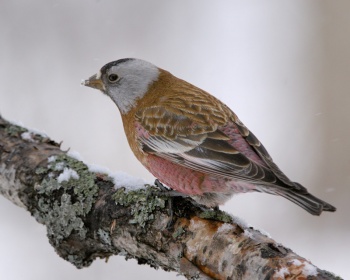m (Gray-crowned Rosy-Finch moved to Gray-crowned Rosy Finch) |
(Additional picture. Taxonomy. References updated) |
||
| Line 1: | Line 1: | ||
| − | [[Image:Grey-crowned_Rosy_Finch.jpg|thumb|550px|right|Photo by {{user|Old+Fulica|Old Fulica}}<br /> | + | [[Image:Grey-crowned_Rosy_Finch.jpg|thumb|550px|right|Photo by {{user|Old+Fulica|Old Fulica}}<br />Vancouver [[British Columbia]], [[Canada]], December 2004]] |
;[[:Category:Leucosticte|Leucosticte]] tephrocotis | ;[[:Category:Leucosticte|Leucosticte]] tephrocotis | ||
| Line 7: | Line 7: | ||
====Similar Species==== | ====Similar Species==== | ||
[[Brown-capped Rosy-Finch]], [[Black Rosy-Finch]]. These are considered conspecific by some authorities. Range differences can help in identification; all have variation in plumage that can make separation tricky. | [[Brown-capped Rosy-Finch]], [[Black Rosy-Finch]]. These are considered conspecific by some authorities. Range differences can help in identification; all have variation in plumage that can make separation tricky. | ||
| − | + | [[Image:18431D200a 6098 80.jpg|thumb|350px|right|Photo by {{user|bstevent|bstevent}}<br />Prince George, [[British Columbia]], [[Canada]], March 2007]] | |
==Distribution== | ==Distribution== | ||
[[Aleutian Islands]] to western [[Canada]] and northwest [[U.S.]] and eastern [[California]]. Winters east to western [[South Dakota]] and [[Nebraska]]. Accidental vagrant to eastern and midwestern [[United States]]. | [[Aleutian Islands]] to western [[Canada]] and northwest [[U.S.]] and eastern [[California]]. Winters east to western [[South Dakota]] and [[Nebraska]]. Accidental vagrant to eastern and midwestern [[United States]]. | ||
==Taxonomy== | ==Taxonomy== | ||
| + | ====Subspecies==== | ||
Seven subspecies are recognized.<sup>[[#References|[1]]]</sup> | Seven subspecies are recognized.<sup>[[#References|[1]]]</sup> | ||
| − | + | *''L. t. umbrina'': | |
| + | :*St Matthew Island and Pribilof Islands (Bering Sea) | ||
| + | *''L. t. griseonucha'': | ||
| + | :*Komandorskiye, [[Aleutian Islands]] and Kodiak islands to [[Alaska]] | ||
| + | *''L. t. littoralis'': | ||
| + | :*Central Alaska to south-western Yukon, western [[Canada]] and north-western [[US]] | ||
| + | *''L. t. irvingi'': | ||
| + | :*Brooks Range (northern Alaska) | ||
| + | *''L. t. tephrocotis'': | ||
| + | :*Mountains of Yukon and western [[Alberta]] to south-eastern [[British Columbia]] and north-western [[Montana]] | ||
| + | *''L. t. wallowa'': | ||
| + | :*Wallowa Mountains (north-eastern [[Oregon]]); winters to western-central [[Nevada]] | ||
| + | *''L. t. dawsoni'': | ||
| + | :*Eastern [[California]] (Sierra Nevada, White and Inyo mountains) | ||
==Habitat== | ==Habitat== | ||
Open ground in tundra areas; in winter open ground in mountainous regions to the south. Some populations are year-round in the Rocky Mountains and Sierra Nevada Mountains of the western [[USA]]. | Open ground in tundra areas; in winter open ground in mountainous regions to the south. Some populations are year-round in the Rocky Mountains and Sierra Nevada Mountains of the western [[USA]]. | ||
==Behaviour== | ==Behaviour== | ||
| − | + | Hops on ground, foraging on tundra, or on high rocky terrain often near, or on, melting snow patches where insects can be found. | |
| − | + | ====Diet==== | |
| + | Their diet consists mostly of seeds, insects, buds and plant shoots. | ||
==References== | ==References== | ||
| − | #{{Ref- | + | #{{Ref-Clements6thAug13}}#Handbook of the Birds of the World Alive (retrieved June 2014) |
{{Ref}} | {{Ref}} | ||
Revision as of 21:37, 16 June 2014
- Leucosticte tephrocotis
Identification
Length 6.25" (16cm.) Wingspan 13" (33cm.). Slender medium-sized bird with long wings and tail adapted for flight at altitude. Plain brown underparts, gray head with black throat and forehead; rosy-pink accents on shoulders and belly, triangular yellow bill. Females are slightly drabber. There are considerable variations in regional subspecies.
Similar Species
Brown-capped Rosy-Finch, Black Rosy-Finch. These are considered conspecific by some authorities. Range differences can help in identification; all have variation in plumage that can make separation tricky.
Distribution
Aleutian Islands to western Canada and northwest U.S. and eastern California. Winters east to western South Dakota and Nebraska. Accidental vagrant to eastern and midwestern United States.
Taxonomy
Subspecies
Seven subspecies are recognized.[1]
- L. t. umbrina:
- St Matthew Island and Pribilof Islands (Bering Sea)
- L. t. griseonucha:
- Komandorskiye, Aleutian Islands and Kodiak islands to Alaska
- L. t. littoralis:
- L. t. irvingi:
- Brooks Range (northern Alaska)
- L. t. tephrocotis:
- Mountains of Yukon and western Alberta to south-eastern British Columbia and north-western Montana
- L. t. wallowa:
- L. t. dawsoni:
- Eastern California (Sierra Nevada, White and Inyo mountains)
Habitat
Open ground in tundra areas; in winter open ground in mountainous regions to the south. Some populations are year-round in the Rocky Mountains and Sierra Nevada Mountains of the western USA.
Behaviour
Hops on ground, foraging on tundra, or on high rocky terrain often near, or on, melting snow patches where insects can be found.
Diet
Their diet consists mostly of seeds, insects, buds and plant shoots.
References
- Clements, J. F., T. S. Schulenberg, M. J. Iliff, B.L. Sullivan, C. L. Wood, and D. Roberson. 2013. The eBird/Clements checklist of birds of the world: Version 6.8., with updates to August 2013. Downloaded from http://www.birds.cornell.edu/clementschecklist/download/
- Handbook of the Birds of the World Alive (retrieved June 2014)
Recommended Citation
- BirdForum Opus contributors. (2024) Gray-crowned Rosy Finch. In: BirdForum, the forum for wild birds and birding. Retrieved 11 May 2024 from https://www.birdforum.net/opus/Gray-crowned_Rosy_Finch





